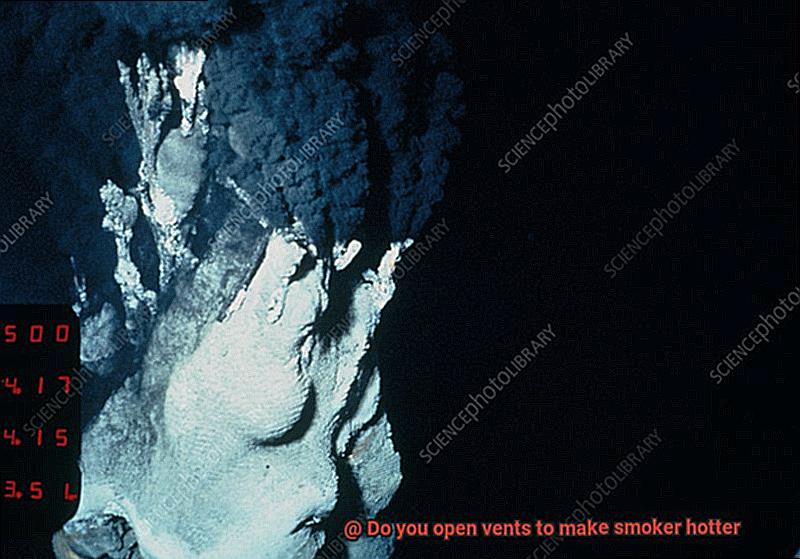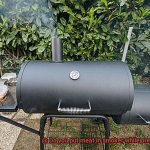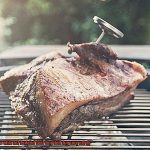If you’ve ever found yourself lost in the smoky haze of backyard barbecuing, then you know the allure of smoking meat. But as you dive deeper into this flavorful world, one question may haunt your dreams: “Do you open vents to make a smoker hotter?” Well, my friend, today we’re here to unlock this secret and take you on a journey through the captivating realm of vent control.
Vent control is like the conductor’s baton in an orchestra – it’s the technique that lets you fine-tune the temperature inside your smoker. With this skill, you can achieve that perfect harmony of heat, smoke, and flavor in every bite. But hold on tight, because mastering vent control isn’t as easy as flipping a switch or cranking those vents wide open. Let’s dig into the nitty-gritty details and uncover the fascinating science behind it all.
So how does this vent control sorcery work? Picture your smoker as a finely-tuned beast ready to unleash mouth-watering magic. Just like any beast worth its salt, it needs proper airflow to perform at its best. And that’s where vents come into play – they’re like little air highways inside your smoker that regulate temperature.
Now here’s the juicy bit: opening those vents allows more oxygen to reach the fire, revving up combustion and cranking up temperatures inside your smoking chamber. It’s like giving your smoker an adrenaline shot. On the flip side, closing those vents restricts airflow, slowing down combustion and cooling things down. So basically, vent control is your key to playing with fire (in a good way) and dialing in just the right amount of heat.
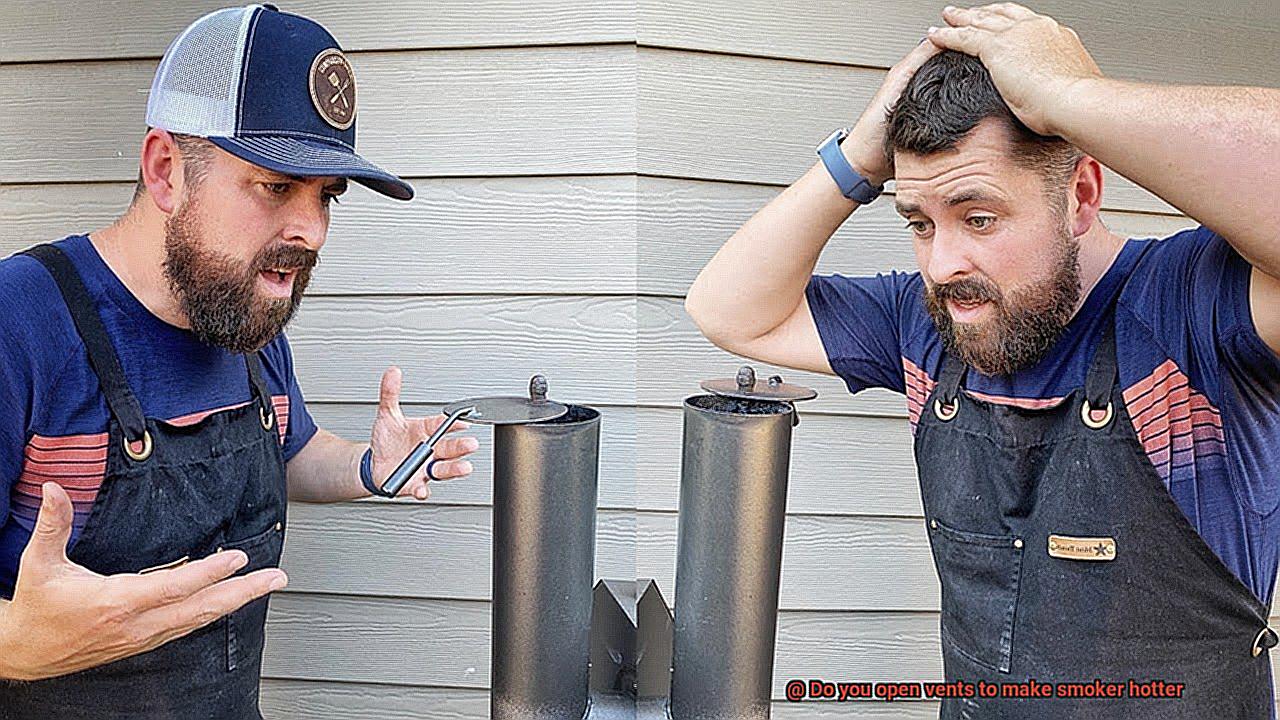
But beware. Vent control is an art form that demands finesse and practice. Wide-open vents won’t instantly turn your smoker into a blazing inferno, just as closed vents won’t guarantee a chillaxed smoking experience. It’s all about finding that sweet spot – adjusting the vents gradually, keeping an eye on the thermometer, and making those tiny tweaks when needed.
Now, here’s where things get interesting. Your smoker has its own personality, its own quirks. Each model is unique, with different vent placements and designs. So pay attention to how your smoker reacts to vent adjustments. Some may thrive on wide-open vents for scorching temperatures, while others prefer gentle nudges
Contents
What is a Smoker?
Enter the world of smoking, where a smoker becomes your secret weapon in infusing delectable smoky flavors into meats and vegetables. But what exactly is a smoker, and how can you harness its full potential? Join us as we explore the captivating realm of smoking and unveil the secrets to becoming a master of this culinary art.
The Anatomy of a Smoker
- Defining a smoker and its purpose in outdoor cooking
- Components of a typical smoker: firebox, cooking chamber, ventilation systems
- Exploring the various shapes and sizes of smokers
- Notable features like temperature control and insulation
Slow and Steady Wins the Flavor Race
- Contrasting smokers with traditional grills in terms of cooking style and temperature range
- Unveiling the benefits of slow-cooking at lower temperatures (225°F to 275°F)
- Understanding how smoke flavors permeate meat during the smoking process

Unlocking the Secrets of Vents – The Key to Temperature Control
- Introducing intake vents and exhaust vents in smokers
- Revealing the crucial role of vents in regulating airflow and heat
- Discovering how opening intake vents increases oxygen supply, boosting combustion rate and raising temperature
- Emphasizing the importance of finding the right balance for optimal temperature control
The Art of Vent Adjustment
- Step-by-step guide on adjusting vents to increase temperature
- Starting with slight openings and gradually increasing for precise adjustments
- Considering other factors such as fuel type and weather conditions for effective vent adjustment
Types of Vents in a Smoker
Imagine a warm summer day, with the tantalizing scent of smoky barbecue filling the air. The secret to achieving that perfect balance of heat and smoke in a smoker lies in understanding and mastering the different types of vents. Join us as we explore the world of smoker vents and discover how they can elevate your grilling game.
Intake Vents: The Gateway to Flavor
Intake vents, also known as bottom vents or air inlets, are essential for supplying fresh air to the smoker. These vents play a crucial role in fueling the fire and controlling the temperature. With adjustable dampers or fixed openings, intake vents allow you to fine-tune the airflow and regulate the heat inside your smoker.
Intake vent designs can vary, from simple holes or slots to adjustable dampers or sliding doors. Some smokers have multiple intake vents, while others have a single vent. Understanding how your smoker’s intake vents work is key to achieving precise temperature control.
Exhaust Vents: Let It Rise and Shine
Located at the top of the smoker, exhaust vents, or chimney vents, release smoke, heat, and gases from the cooking chamber. By adjusting these vents, you can control the amount of heat and smoke retained or released from your smoker. Whether it’s adjustable chimneys or fixed openings, understanding your exhaust vents is crucial for maintaining optimal smoking conditions.
Exhaust vent designs can also vary among smokers. Some smokers feature adjustable chimneys with dampers that allow for precise control over airflow, while others have fixed openings that cannot be modified. Familiarizing yourself with your smoker’s exhaust vent configuration is essential for achieving the desired cooking temperature.
Finding the Perfect Balance: Intake vs. Exhaust
Achieving the ideal temperature in your smoker is all about finding the perfect balance between intake and exhaust vents. Opening intake vents allows more air to enter, resulting in a hotter fire. On the other hand, opening exhaust vents allows excess heat and smoke to escape, lowering the temperature inside your smoker. Experimentation is key to finding that sweet spot for your specific smoker and desired cooking temperature.
Vent Variations: A World of Possibilities
Smokers come in different shapes and sizes, and so do their vents. Some smokers boast multiple intake and exhaust vents scattered throughout the cooking chamber, while others have a single vent for each. Familiarizing yourself with your smoker’s vent configuration ensures you can make precise adjustments and maintain that perfect temperature.
Beyond Intake and Exhaust: Extra Venting Options
Some smokers offer additional venting options such as side vents or extra dampers. These extra vents provide even more control over airflow and heat distribution within your smoker. Understanding how these additional vents work adds another tool to your grilling arsenal.
How Opening Vents Affects the Temperature in a Smoker
Are you ready to unlock the secrets behind achieving that perfect balance of heat and smoke in your smoker? Today, we dive deep into the world of vents and their impact on temperature control. Grab your apron, fire up your grill, and let’s explore the fascinating science behind opening vents in your smoker.
The Gatekeepers of Temperature:
Vents are like the gatekeepers of your smoker’s temperature. They control the airflow, which directly influences the combustion process and the amount of oxygen available for the fire. When vents are closed, airflow is restricted, depriving the fire of oxygen and causing the temperature to drop. In contrast, opening the vents allows for increased airflow, providing a boost of oxygen and promoting better combustion, resulting in a higher temperature.
Size and Number: A Game-Changer:
Not all vents are created equal. The size and number of vents in your smoker can significantly impact temperature control. Larger or multiple vents allow more airflow, leading to a faster increase in temperature. If you’re looking to crank up the heat quickly, open those vents wide.
Finding the Sweet Spot:
While opening vents can make your smoker hotter, finding the right balance is crucial. Too much air can cause fuel to burn too quickly, leading to uncontrollable high temperatures. On the other hand, insufficient airflow results in lower temperatures and incomplete combustion. Experimenting with vent adjustments and monitoring your smoker’s temperature helps you find that sweet spot for perfect cooking conditions.
Vent Adjustments: The Key to Consistency:
Maintaining consistent temperatures during smoking requires ongoing vent adjustments. Keep a close eye on that thermometer and make small changes to the vent openings as needed. This ensures optimal cooking conditions and unleashes your culinary creativity.
Customization and Vent Variations:
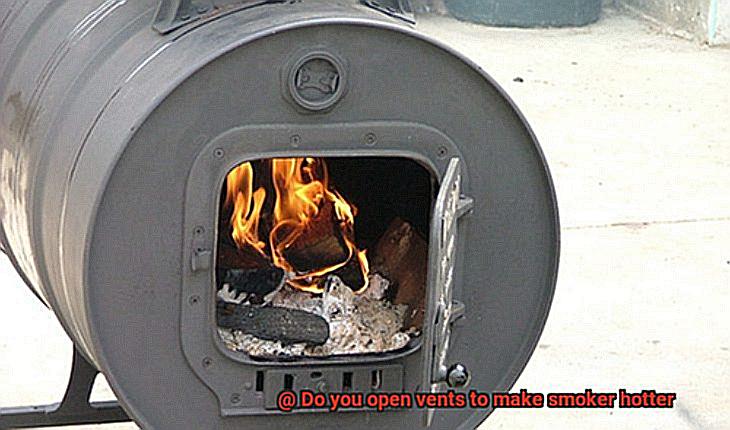
Each smoker has its own unique design, with vent variations aplenty. Some smokers feature additional dampers or adjustable vents for precise control over airflow and temperature. Embrace the uniqueness of your smoker and experiment with different vent configurations to find what works best for you.
Striking the Right Balance in Vent Adjustments
In this guide, we will delve into the secrets of finding the sweet spot that strikes the perfect balance between heat and flavor in your smoker. Get ready to unlock the key to tender, juicy, and mouthwateringly delicious grilled meats. Grab your tongs and let’s embark on this flavorful journey together.
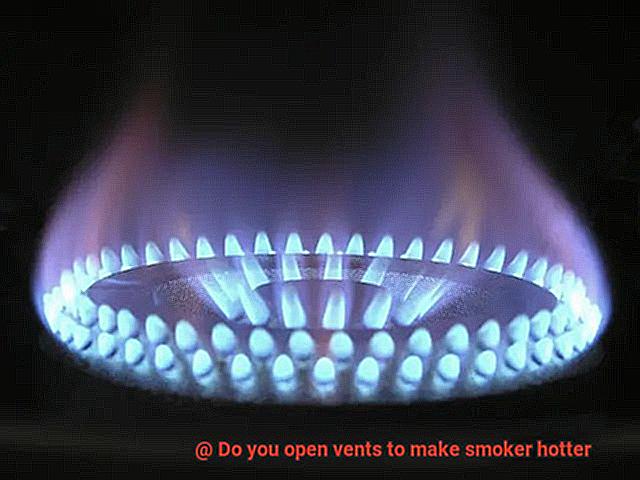
The Importance of Vent Adjustments:
Think of your smoker as a well-oiled machine, with vents acting as control knobs. These vents regulate the flow of oxygen, directly impacting the temperature inside your cooking chamber. Adjusting them is like having a thermostat for your grill. But beware, swing those vents wide open, and you risk an uncontrollable surge in airflow that can scorch your precious ribs to charcoal bricks. Keep them closed entirely, and you suffocate your fire, resulting in frustratingly low temperatures.
Striking the Perfect Balance:
To strike that perfect balance, start by partially opening those vents. This allows just enough oxygen to maintain a consistent heat level while preventing flare-ups and excessive smoke production. It’s like finding the elusive middle ground between too hot and too cold. But remember, keep an eye on that temperature gauge; it’s crucial during this process.
Pro Tips for Vent Adjustments:
- Gradual Adjustments: Fine-tune your vent adjustments by making gradual changes. If the temperature is rising too slowly, open the vents slightly more for increased airflow. Remember, it’s easier to add heat gradually than to bring it down once it gets too high.
- Fuel Considerations: Different fuels require different vent adjustments. Charcoal smokers generally need more airflow compared to wood smokers. Understanding how your specific smoker and fuel source work together will help you make accurate vent adjustments like a seasoned pitmaster.
- Weather Impact: Weather conditions, such as windy days, can influence vent adjustments. Wind increases airflow inside the smoker, affecting temperature control. Adjust the vents accordingly to maintain a steady heat level when the wind starts to blow.
Other Factors That Impact Temperature in a Smoker
As you embark on your journey to become the ultimate pitmaster, it’s important to understand that achieving perfect temperature control in your smoker involves more than just adjusting the vents. In this article, we’ll delve into the other factors that can impact temperature and help you achieve mouthwatering results every time you fire up your grill.
Fuel Type:
Different fuels have different combustion rates and heat outputs. Charcoal burns hotter and faster than wood chips or pellets. Consider the fuel you’re using and adjust the vent openings accordingly to maintain the desired temperature. Experiment with different fuel types to discover your favorite flavor profiles.
Quantity of Fuel:
The amount of fuel you use directly affects heat generation and temperature maintenance. Overloading your smoker can result in excessive heat that’s difficult to control, while insufficient fuel may struggle to reach and maintain desired temperatures. Finding the right balance is key.
Placement and Arrangement of Fuel:
Evenly distribute your fuel within the smoker for consistent heat distribution. Consider using a charcoal basket or firebox divider to manage heat better. Avoid piling up fuel on one side as it can lead to uneven heating.
External Weather Conditions:
Windy conditions can increase airflow through the vents, causing temperature fluctuations. Cold weather may make it harder to maintain high temperatures inside the smoker, requiring adjustments to both vent settings and cooking times.
Size and Design of Smoker:
The size of your smoker affects how much fuel is needed and how wide you need to open the vents for optimal temperature control. Larger smokers require more fuel and wider vent openings, while smaller smokers heat up quicker and may need frequent vent adjustments.
Cooking Method:
Different cooking methods require different temperature ranges. Low-and-slow smoking demands lower temperatures over an extended period, while hot and fast grilling requires higher temperatures for shorter cooking times. Adjust your vent settings accordingly to achieve the desired outcome.
Tips for Controlling Temperature in a Smoker
Temperature control is the secret ingredient that separates the mediocre from the magnificent when it comes to smoking meat. And guess what? It’s all about those vents. In this guide, we’ll explore the importance of controlling temperature in a smoker and how to do it effectively using vents. So, let’s dive into some tips that will have you grilling like a boss.
Understanding Your Smoker:
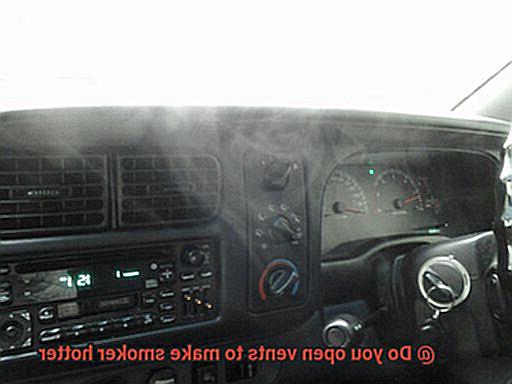
Just like every individual is unique, so is every smoker. Different smokers have different vent configurations, such as top vents or side vents, or even a combination of both. It’s crucial to get acquainted with your specific smoker’s vent system before firing it up.
Experiment with Vent Positions:
Now that you know your smoker, it’s time to play with those vents. Opening the vents allows more oxygen in and raises the temperature, while closing them restricts airflow and lowers the heat. Be bold and try different positions to see how they affect your smoker’s temperature. It’s like being a mad scientist in your own backyard laboratory.
Start with a Fully Open Vent:
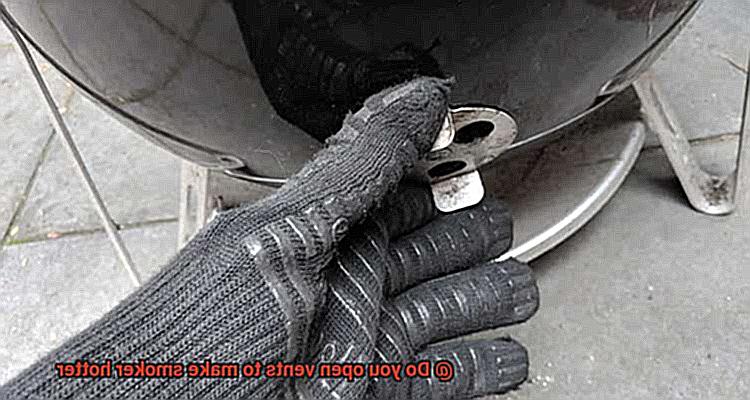
When igniting your smoker, begin with all vents fully open. This maximizes airflow, getting that fire roaring and bringing the temperature up quickly. Once you reach your desired temperature, then you can make those fine-tuning adjustments.
Gradually Adjust Vents:
Patience is key here, my grilling gurus. Instead of making big changes all at once, make small adjustments to the vents. Big changes can cause wild temperature swings, and we want steady heat for smokin’ success. Remember, slow and steady wins the race.
Monitor and Make Adjustments:
Keep an eagle eye on that thermometer, friends. Regularly check the temperature and make any necessary adjustments to keep it steady. Wind and weather can be mischievous and mess with your heat, so be prepared to tweak those vents as needed.
Utilize Additional Methods:
Controlling temperature isn’t just about vents. You can also use water pans or heat deflectors to help regulate the temperature. Adjusting the placement of charcoal or wood chips can affect the heat distribution. Insulation blankets can provide extra insulation during colder weather. These techniques work hand in hand with vent adjustments to give you ultimate temperature control.
Practice Makes Perfect:
Remember, becoming a temperature control ninja takes practice and experience. Each smoker has its own quirks, so take notes, learn from your cooking adventures, and keep experimenting. Before you know it, you’ll be the grilling master of your neighborhood.
Common Mistakes to Avoid When Adjusting Vents
In this guide, we’ll explore the common mistakes to avoid when adjusting vents on your smoker. Whether you’re a seasoned grill master or a beginner, these tips will help you achieve optimal heat control and ensure deliciously smoked food every time.
Opening the Vents Too Wide:
Don’t let your enthusiasm get the best of you by opening the vents too wide. While it may seem like a quick fix to increase heat, it can lead to disaster. Excessive airflow turns up the heat too quickly, risking burnt food. Instead, start with small adjustments and gradually open the vents until you reach your desired temperature.
Improper Vent Regulation:
Avoid sudden changes in vent positions during smoking. Gradual adjustments are key to temperature control and prevent drastic fluctuations that can ruin your cooking. Remember, patience is essential when it comes to vent regulation.
Balancing Intake and Exhaust Vents:
Maintaining harmony between intake and exhaust vents is crucial for even heat distribution. Neglecting to balance these vents disrupts the equilibrium, resulting in uneven cooking. Adjust both vents accordingly to maintain consistent heat throughout the smoker.
Constantly Tinkering with Vents:
Resist the urge to constantly fiddle with the vents during smoking. Give your smoker time to adjust before making further changes. Constant tinkering causes temperature swings and affects your overall cooking time.
Ignoring External Factors:
Don’t overlook external factors like weather conditions when adjusting vents. Wind, rain, and temperature all impact your smoker’s performance. Be mindful of these factors and make necessary adjustments to compensate for changes in airflow.
Neglecting Vent Maintenance:
Regularly clean and maintain your vents for optimal performance. Grease and debris build-up obstruct airflow and affect temperature control. Take the time to clean your vents, ensuring they function optimally and prevent potential problems during smoking sessions.
CuVIwLv30tI” >
Conclusion
In conclusion, the act of opening vents on a smoker does indeed help in making it hotter.
By allowing more oxygen to flow into the firebox, the flames are fueled and the temperature rises. It’s like giving your smoker a breath of fresh air, revving up its heat and enhancing the cooking process.
So, when you’re aiming for that perfect sear or melt-in-your-mouth tenderness, don’t hesitate to crack open those vents and let the fire roar.

